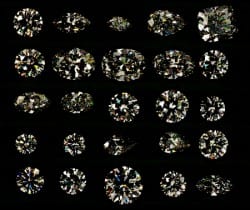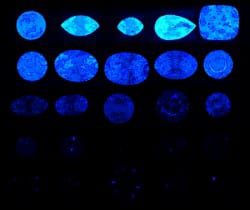

Twenty-five years ago GIA published the results of a human experiment in the observation of diamonds with various amounts of blue fluorescence. An introductory editorial indicated that this study “should bring into question the trade’s lower ‘bid’ prices for moderate to highly fluorescent diamonds in the better colors”.
GIA was addressing the negative publicity concerning blue fluorescent diamonds, which began during the diamond investment craze of the late 70’s, early 80’s. Since then blue fluorescence has been an obstacle to marketing, leading to discounting compared to non-fluorescent diamonds of the same color grade.
There are several reasons, mostly due to misinformation and misguided publicity, for the concern and distrust by consumers and the trade of these gemstones that glow blue when excited in the dark by ultra violet (UV) radiation (Figure 2). In her ‘Diamond Ring Buying Guide’, Renee Newman notes ‘it’s been said that “If a diamond has fluorescence it will have an oily, cloudy or milky appearance”. You can prove this is false by just looking at some transparent fluorescent diamonds’ (such as those in Figure 1).
There is a valid reason for discounting diamonds with medium to very strong fluorescence. That is the overgrading of color that is too often observed in the trade. Overgrading results from the whitening effect due to blue fluorescence that is stimulated in the diamond due to use of UV-containing, fluorescent lighting in color grading.